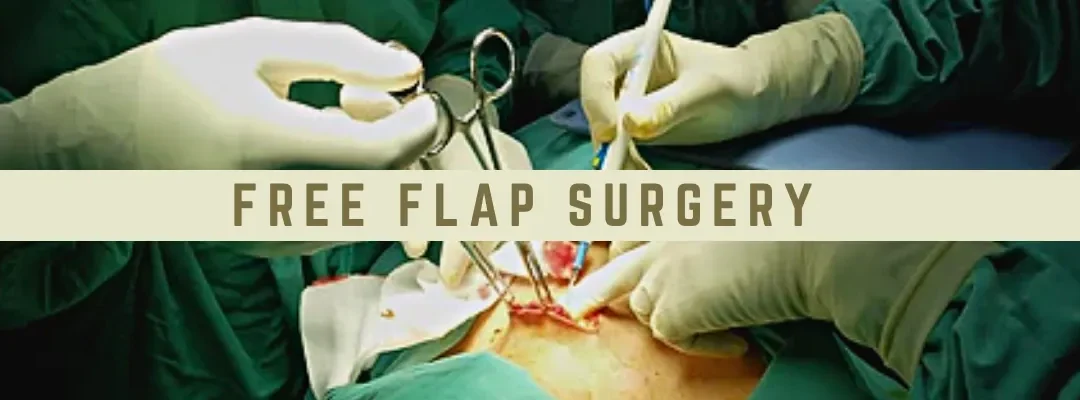A flap is a tissue that is taken with its blood vessels from one part of the body and used to cover a wound or reconstruct defects elsewhere in the body. A free flap is a portion of tissue removed from the body with its blood vessels ( cutting off from its original blood supply) and then transferred to cover the defect elsewhere on the body (recipient site) and restoring its blood supply by joining its blood vessels to vessels at the recipient site.
Dr. Leena Jain, a renowned plastic surgeon in Borivali, Mumbai, says that free flap surgery has changed the face of reconstructive surgery.

In this procedure, the blood vessels transporting blood to and from the flap tissue being used are severed and then rejoined to a different source of blood supply (at the recipient site) such that the defect is covered with a healthy living flap, using microsurgery.
Microvascular surgery involves stitching two tiny blood vessels together under magnification, often using a microscope so that blood flows smoothly from one vessel to another.
What are the indications of free flap surgery?
- Patients who have been diagnosed with head and neck cancer are frequently treated with surgery. Tumors in the throat and mouth that are removed can significantly impair speech and swallowing.
- Similarly, removing jaw bone, when involved in cancer impacts the patient’s appearance and function. The leftover woundsare often too extensive, and the tissue taken with the tumor has to be replaced. In such cases, fixing the deficiency with a “free flap” may be a viable alternative to rectify the defect and restore the appearance and function of the affected area.
- Free flap surgery is also necessary to cover deep open wounds in accident victims and patients with burns.
- It is also a viable surgery for rehabilitating and reconstructing congenital (present from birth) defects.
- Free flaps are indicated in Diabetic Foot Reconstruction- diabetics have ulcers on their feet commonly. Ulcers are cleaned and dead tissue is removed. Large ulcers are then covered well with free flaps if foot needs to be saved otherwise extensive wounds can land up in leg amputation.
- Free flaps are required in old nerve injuries of the limbs of the face to restore function of movement and smile; like in brachial plexus injury and in facial palsy and urinary bladder reconstruction.
Dr. Leena Jain, adds that different types of tissues can be transferred to reconstruct various defects with varied tissue components- like replacement of bone for bone, muscle for muscle, fat for fat, and skin for skin.
What are the contraindications of free flap surgery?
Any medical condition preventing a prolonged operative procedure. This contraindication is relevant to any significant procedure anywhere on the body. A history of excess bleeding or clotting (coagulopathy)that can result in a hypercoagulable state.
Other contraindications include uncontrolled diabetes, cardiac issues, etc. or if the patient is unfit for major surgery.
vasculitis, venous insufficiency, and connective tissue disorders, Dr. Leena Jain, among the leading microsurgeons in Mumbai, points out that the patient’s physiologic health is far more essential than their chronological age in establishing the suitability of free flap surgery.
What are the merits of free flap surgery?
Like any other Plastic surgery, free flap surgery has both aesthetic and functional benefits. The following are some of the benefits of the free flap procedure:
- The coverage provided by the free flap procedure is highly stable and sturdy, with very few risks of flap breaking or being damaged.
- The tissue match is excellent and natural in terms of color, contour, etc.
- Healthy tissue is used to aid to combat infection, and accelerate healing and coverage of wounds.
- Restores functions like the functioning muscles used to smile or move hands and fingers.
- Restores tissue losses sustained due to accidents, tumors, infections, burns, developmental deformities, etc.
What are the demerits of free flap surgery?
Every surgery comes with its own set of hazards, and free flap surgery is no exception. The following are some of the demerits of the free flap procedure:
- Flap failure, which is defined as necrosis or tissue death.
- Need for 7 – 10days of hospitalization.
- Bulky flaps due to tissue thickness which may need a second surgery to improve contour
Conclusion

Going through an accident or an ailment that requires surgery can be painful enough, and if you are left with deep wounds that are not visually appealing can be disheartening. Furthermore, such deep wounds become a constant reminder of the ordeal you went through.
Fortunately, free flap surgery can come to your rescue due to advancements in the medical field. The success rate of free tissue or flap surgery has been steadily improving, with most recent studies reporting a rate of 90% – 95%.
If you are considering getting free flap surgery, please contact Dr. Leena Jain, a top-notch plastic surgeon in Mumbai.
Dr. Leena Jain believes everyone has the right to feel comfortable in their skin. She keeps herself, and her plastic surgery clinic in Mumbai updated on reconstructive and microvascular surgery so she can help improve the quality of her patients’ lives.

